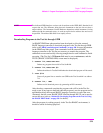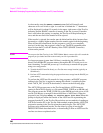
385
Chapter 7, IBASIC Controller
Method #3. Developing Programs Using Word Processor on a PC (Least Preferred)
Method #3. Developing Programs Using Word Processor on a PC
(Least Preferred)
The third method of IBASIC program development is to write the program using a
word processor on a PC, save it as an ASCII file, and then download it into the
Test Set through the serial port. The benefit of this method is that it can be done on
the PC without connecting to a Test Set until download and no BASIC language
compiler/interpreter is needed. The primary drawback is that no syntax checking
occurs until the downloaded program is run on the Test Set. A second drawback is
that, especially for longer programs (>100 lines), it is very time-consuming to
transfer the code into the Test Set.
Configuring a Word Processor
The word processor on which the IBASIC code is developed must be able to save
the file in ASCII format and have an ASCII file transfer utility. This is necessary
because word processors use a variety of escape codes to mark all the special
display formats such as bold face, font size, indented text, and the like. When a
word processor file is stored in ASCII format, all escape codes are stripped off.
The ASCII file transfer utility is used to transfer the file to the Test Set.
NOTE: The GET command can be used on external BASIC language controllers to load ASCII files
containing IBASIC programs developed on word processors. Once loaded, the steps for
downloading described in “Method #1. Program Development on an External BASIC
Language Computer” on page 375 can be used to transfer the program to the Test Set.


















